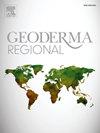巴西南部不同土壤质地免耕玉米nbpt处理尿素氨挥发
IF 3.3
2区 农林科学
Q2 SOIL SCIENCE
引用次数: 0
摘要
在免耕(NT)系统中,尿素经脲酶抑制剂处理后可显著减少氨损失,但场地条件可能影响其效率。本研究的目的是评价在巴西南部两个不同土壤质地、天气和管理的地点,在普通尿素上施用NBPT [N-(正丁基)硫磷三酰胺]减少免耕玉米NH3挥发的效率;并评价NBPT对尿素水解后土壤pH和NH4+升高延迟的抑制作用。2016/17生长季,在瓜拉普瓦(GUA) (Rodhic Hapludox,粘土)和南埃尔多拉多(Eldorado do Sul, ELD)(典型古砂质粘土壤土)进行了两项田间试验。处理为:(i)普通尿素(U)和(ii) U +脲酶抑制剂(U + NBPT), (iii)不施氮对照。施氮量为100 ~ 180 kg ha - 1。在室内,采用U和U + NBPT对两种土壤进行了尿素水解试验。在砂质土壤中,U的NH3挥发比粘土土壤更快、更高,在施氮后的前5天达到施氮量的26%,而在GUA土壤中为10%。在此期间,NBPT在沙土(ELD)和GUA(粘土)中分别减少了83%和88%的尿素NH3损失。在此之后,降雨有利于氮肥在ELD的扩散,但不利于GUA的扩散,其中U的NH3损失量从10%增加到14%,U + NBPT的NH3损失量从1%增加到7%,降低了抑制剂的效率。在控制条件下,施用U后5 d内,土壤NH4+含量可达207 ~ 224 mg kg - 1, pH值可达6.8 ~ 8.1,而施用U + NBPT时,NH4+峰值可降至72 ~ 109 mg kg - 1, pH值可降至6.2 ~ 7.2,两种土壤NH4+的效率相似。免耕玉米在施用尿素后的前5 d内,NH₃挥发导致的氮素损失较为严重,特别是在沙质土壤中。nbpt处理的尿素是一种有效的氮素管理方法,可以减少砂质和粘土中氨的损失;然而,除了降雨事件外,其效率随时间的推移而降低。进一步的研究应探索其他策略,以优化NBPT在免耕系统中减少尿素NH3损失的效率。本文章由计算机程序翻译,如有差异,请以英文原文为准。
Ammonia volatilization from NBPT-treated urea in no-till maize at different soil textures in South Brazil
Urea treated with urease inhibitors can significantly reduce NH3 losses when urea is surface applied to the straw in a no-till (NT) system, but the site conditions may affect its efficiency. The aims of this study were to evaluate the efficiency of the NBPT [N-(n-butyl) thiophosphoric triamide] applied to common urea on the decrease of NH3 volatilization in no-till maize in two sites with distinct soil textures, weather, and management in southern Brazil; and to evaluate the NBPT inhibition in delayed soil pH and NH4+ elevation after urea hydrolysis. Two field experiments were conducted in the 2016/17 growing season at Guarapuava (GUA) (Rodhic Hapludox, clay) and Eldorado do Sul (ELD) (Typic Paleudult, sandy clay loam). The treatments were: (i) common urea (U) and (ii) U + urease inhibitor (U + NBPT), and (iii) control without N fertilization. The N sources were broadcast applied to maize at N rate of 100–180 kg ha−1. In the laboratory, an experiment was conducted using U and U + NBPT, applied to the two soils, to evaluate urea hydrolysis. The NH3 volatilization from U was faster and higher in the sandy soil compared to clayey soil, reaching 26 % of N applied in the first five days after application, compared to 10 % in GUA. In this period, the NBPT reduced the NH3 loss from urea by 83 % in sandy soil (ELD) and 88 % in GUA (clay). After this period, rain events occurred, which favoured the diffusion of N from fertilizer in ELD, but not in GUA, where NH3 losses increased from 10 to 14 % with U, and from 1 to 7 % with U + NBPT, reducing the efficiency of the inhibitor. Under controlled conditions, U application increased soil NH4+ levels up to 207 to 224 mg kg−1, and soil pH up to 6.8–8.1 in five days after application, while in U + NBPT the NH4+ peak was reduced to 72 to 109 mg kg−1 and pH to 6.2–7.2, showing similar efficiency in both soils. Nitrogen losses through NH₃ volatilization were intense during the first five days after urea application in no-till maize, especially in sandy soil. NBPT-treated urea is an effective N management practice in reducing ammonia losses in both sandy and clay soils; however, its efficiency decreases over time in the clay soil besides rainfall events. Further studies should investigate additional strategies to optimize NBPT efficiency in reducing NH3 loss from urea in no-till systems in clay soils.
求助全文
通过发布文献求助,成功后即可免费获取论文全文。
去求助
来源期刊

Geoderma Regional
Agricultural and Biological Sciences-Soil Science
CiteScore
6.10
自引率
7.30%
发文量
122
审稿时长
76 days
期刊介绍:
Global issues require studies and solutions on national and regional levels. Geoderma Regional focuses on studies that increase understanding and advance our scientific knowledge of soils in all regions of the world. The journal embraces every aspect of soil science and welcomes reviews of regional progress.
 求助内容:
求助内容: 应助结果提醒方式:
应助结果提醒方式:


